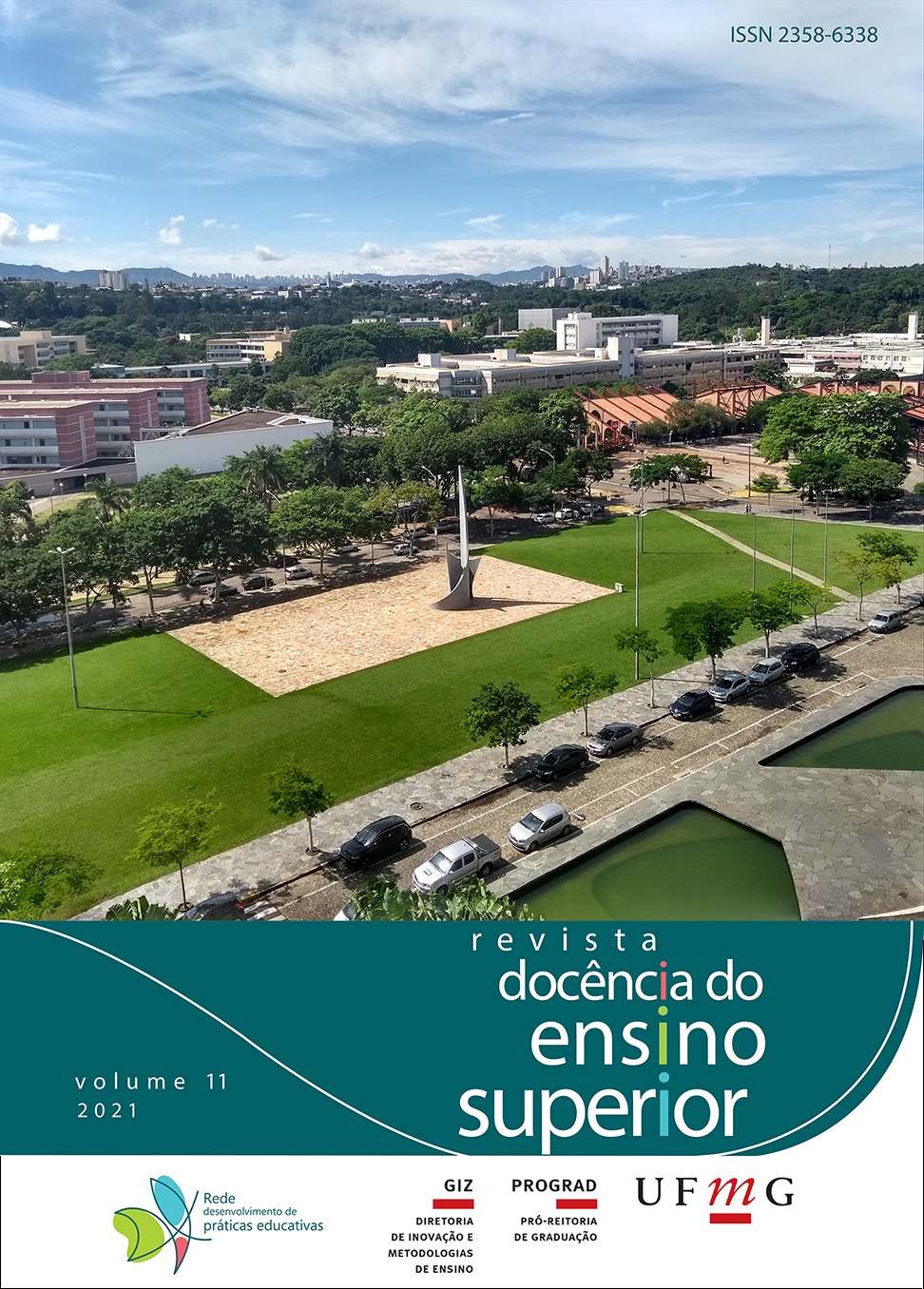Why do college students manifest stress, anxiety, and depression?
A rapid review of longitudinal studies
DOI:
https://doi.org/10.35699/2237-5864.2021.29593Keywords:
Anxiety, Depression, College students, Higher education, Mental healthAbstract
Many mental health problems start or are aggravated by entering college. The goal of this article was to identify factors related to stress, anxiety and depression in college students from longitudinal studies. A review was carried out on the databases Medline, Web of Science, SCOPUS and PsycInfo. An additional search was also carried out in the first one hundred results of Google Scholar and in the references of the eligible articles. Two factors' groups were identified: 1) environmental and/or social: adverse experiences in childhood, fragility of social relationships, and time of exposure to electronic media; 2) personal: beliefs about oneself, inability to modify self-attributes, personality traits, and dysfunctional cognitions linked with stressful events. It was concluded that the knowledge of the causes of stress, anxiety, and depression is important to identify students at risk and plan actions that encourage the search for help and the development of skills for stress management.
Downloads
References
AMERICAN PSYCHIATRIC ASSOCIATION. Manual Diagnóstico e Estatístico de Transtornos Mentais. 5. ed. Porto Alegre: Artmed, 2014.
ARAÚJO, Crislaine Luisa; BRESSAN, Vânia Regina. Ações de promoção à saúde, atenção psicossocial e educacional como práticas de integração universitária. In: CONFERENCIA LATINOAMERICANA SOBRE ABANDONO EN LA EDUCACIÓN SUPERIOR, 7., 2017, Córdoba. Anais [...]. Córdoba: Universidad Nacional de Córdoba, 2017. Disponível em: https://revistas.utp.ac.pa/index.php/clabes/article/view/1618. Acesso em: 14 abr. 2021.
ARENAS, Daniel Luccas et al. Pega Leve – Saúde mental do estudante universitário: um relato de experiência. Trabalho (En)Cena, Palmas, v. 4, n. 2, p. 519-530, 2019.
AUERBACH, Randy Patrick et al. WHO World Mental Health Surveys International College Student Project: prevalence and distribution of mental disorders. Journal of Abnormal Psychology, Washington, v. 127, n. 7, p. 623-638, 2018. DOI: https://doi.org/10.1037/abn0000362.
BELASCO, Isabel Cristina; PASSINHO, Renata Soares; VIEIRA, Valéria Aparecida. Práticas integrativas e complementares na saúde mental do estudante universitário. Arquivos Brasileiros de Psicologia, Rio de Janeiro, v. 71, n. 1, p. 103-111, 2019. DOI: https://dx.doi.org/10.36482/1809-5267.ARBP2019v71i1p.103-111.
BETTIS, Alexandra H. et al. Comparison of two approaches to prevention of mental health problems in college students: enhancing coping and executive function skills. Journal of American College Health, v. 65, n. 5, p. 313-322, 2017. DOI: https://doi.org/10.1080/07448481.2017.1312411.
BILEVICIUS, Elena et al. Shame mediates the relationship between depression and addictive behaviours. Addictive Behaviors, v. 82, p. 94-100, 2018. DOI: https://doi.org/10.1016/j.addbeh.2018.02.023.
BURKE, Anne S. et al. Rationale, methods, feasibility, and preliminary outcomes of a transdiagnostic prevention program for at risk college students. Frontiers in Psychiatry, v. 10, p. 1030, 2019. DOI: https://doi.org/10.3389/fpsyt.2019.01030.
DRAKE, Emily C.; SLADEK, Michael R.; DOANE, Leah D. Daily cortisol activity, loneliness, and coping efficacy in late adolescence: a longitudinal study of the transition to college. International Journal of Behavioral Development, v. 40, n. 4, p. 334-345, 2016. DOI: https://doi.org/10.1177%2F0165025415581914.
DROUIN, Michelle et al. College students in distress: can social media be a source of social support. College Student Journal, Alabama, v. 52, n. 4, p. 494-504, 2018.
EBERT, David D. et al. Prediction of major depressive disorder onset in college students. Depression and Anxiety, v. 36, n. 4, p. 294-304, 2019. DOI: https://doi.org/10.1002/da.22867.
FISKE, Abigail; HOLMBOE, Karla. Neural substrates of early executive function development. Developmental Review, v. 52, p. 42-62, 2019. DOI: https://doi.org/10.1016/j.dr.2019.100866.
GANANN, Rebecca; CILISKA, Donna; THOMAS, Helen. Expediting systematic reviews: methods and implications of rapid reviews. Implementation Science, California, v. 5, n. 56, 2010. DOI: https://doi.org/10.1186/1748-5908-5-56.
HE, Yini et al. Levels of neuroticism differentially predict individual scores in the depression and anxiety dimensions of the tripartite model: a multiwave longitudinal study. Stress and Health, v. 34, n. 3, p. 435-439, 2018. DOI: https://doi.org/10.1002/smi.2803.
KARATEKIN, Canan. Adverse Childhood Experiences (ACEs), stress and mental health in college students. Stress and health, v. 34, n. 1, p. 36-45, 2018. DOI: https://doi.org/10.1002/smi.2761.
KUJAWA, Autumn et al. Altered development of amygdala-anterior cingulate cortex connectivity in anxious youth and young sdults. Biological Psychiatry: Cognitive Neuroscience and Neuroimaging, California, v. 1, n. 4, p. 345-352, 2016. DOI: https://doi.org/10.1016/j.bpsc.2016.01.006.
LEÃO, Andrea Mendes et al. Prevalência e fatores associados à depressão e ansiedade entre estudantes universitários da área da saúde de um grande centro urbano do Nordeste do Brasil. Revista Brasileira de Educação Médica, Brasília, v. 42, n. 4, p. 55-65, 2018. DOI: https://dx.doi.org/10.1590/1981-52712015v42n4rb20180092.
LIU, Huijun et al. Gender differences in the influence of social isolation and loneliness on depressive symptoms in college students: a longitudinal study. Social Psychiatry and Psychiatric Epidemiology, London, v. 5, p. 1-7, 2019. DOI: https://doi.org/10.1007/s00127-019-01726-6.
MARTIN, Rebecca E.; OCHSNER, Kevin N. The neuroscience of emotion regulation development: implications for education. Current Opinion in Behavioral Sciences, v. 10, p. 142-148, 2016. DOI: https://doi.org/10.1016/j.cobeha.2016.06.006.
MCLAFFERTY, Margaret et al. Mental health, behavioural problems and treatment seeking among students commencing university in Northern Ireland. PLOS ONE, San Francisco, v. 12, n. 12, e0188785, 2017. DOI: https://doi.org/10.1371/journal.pone.0188785.
MURIS, Peter; MEESTERS, Cor; VAN ASSELDONK, Mike. Shame on me! Self-conscious emotions and big five personality traits and their relations to anxiety disorders symptoms in young, non-clinical adolescents. Child Psychiatry and Human Development, v. 49, n. 2, p. 268-278, 2018. DOI: https://doi.org/10.1007/s10578-017-0747-7.
PEDRELLI, Paola et al. College students: mental health problems and treatment considerations. Academic Psychiatry, v. 39, n. 5, p. 503-511, 2015. DOI: https://dx.doi.org/10.1007%2Fs40596-014-0205-9.
PIMENTA, Gisele. Felicidade se estuda na faculdade. UnB Notícias, 2018. Disponível em: https://noticias.unb.br/67-ensino/2392-felicidade-se-estuda-na-faculdade. Acesso em: 14 abr. 2021.
PORTER, Andrew C. et al. Self-evaluation and depressive symptoms: a latent variable analysis of self-esteem, shame-proneness, and self-criticism. Journal of Psychopathology and Behavioral Assessment, v. 41, n. 2, p. 257-270, 2019. DOI: https://psycnet.apa.org/doi/10.1007/s10862-019-09734-1.
SCHRODER, Hans S. et al. The fixed mindset of anxiety predicts future distress: a longitudinal study. Behavior Therapy, v. 50, n. 4, p. 710-717, 2019. DOI: https://doi.org/10.1016/j.beth.2018.11.001.
SEDERER, Lloyd I. The social determinants of mental health. Psychiatric Services, v. 67, n. 2, p. 234-235, 2016. DOI: https://doi.org/10.1176/appi.ps.201500232.
SHIM, Ruth et al. The social determinants of mental health: an overview and call to action. Psychiatric Annals, v. 44, n. 1, p. 22-26, 2014.
SONG, Yuqing et al. Incidence and risk factors of depressive symptoms in chinese college students. Neuropsychiatric Disease and Treatment, v. 16, p. 2449-2457, 2020. DOI: https://doi.org/10.2147/NDT.S264775.
STEPHANOU, Katerina et al. Hard to look on the bright side: neural correlates of impaired emotion regulation in depressed youth. Social Cognitive and Affective Neuroscience, v. 12, n. 7, p. 1138-1148, 2017. DOI: https://dx.doi.org/10.1093%2Fscan%2Fnsx039.
UNIVERSIDADE DE BRASÍLIA. Núcleo de Apoio Psicopedagógico e Bem Estar do Estudante de Medicina. Regimento do NAPEM/UnB da Faculdade de Medicina. Brasília: NAPEM/UnB, 2014. Disponível em: http://fm.unb.br/graduacao/nucleos/nucleo-de-apoio. Acesso em: 14 abr. 2021.
VANTIEGHEM, Michelle R.; TOTTENHAM, Nim. Neurobiological programming of early life stress: functional development of amygdala-prefrontal circuitry and vulnerability for stress-related psychopathology. In: VERMETTEN, E.; BAKER, D.; RISBROUGH, V. (ed.). Behavioral Neurobiology of PTSD. New York: Springer, 2018. p. 117-136. Current Topics in Behavioral Neurosciences, v. 38. DOI: https://doi.org/10.1007/7854_2016_42.
WU, Xiaoyan et al. Impact of screen time on mental health problems progression in youth: a 1-year follow-up study. BMJ Open, v. 6, n. 11, e011533, 2016. DOI: http://dx.doi.org/10.1136/bmjopen-2016-011533.
XIAO, Jing et al. “Weakest Link” as a cognitive vulnerability within the hopelessness theory of depression in chinese university students. Stress and Health, v. 32, n. 1, p. 20-27, 2016. DOI: https://doi.org/10.1002/smi.2571.
Downloads
Published
Issue
Section
License
Copyright (c) 2021 Thaís Branquinho Oliveira Fragelli, Ricardo Ramos Fragelli

This work is licensed under a Creative Commons Attribution 4.0 International License.
Authors who publish in this journal retain the copyright and grant the journal the right of first publication, with the work simultaneously licensed under the Creative Commons Attribution License which allows the sharing of work with acknowledgment of authorship and initial publication in this journal.
Authors are authorized to take additional contracts separately, for non-exclusive distribution of the version of the work published in this journal (e.g. publish in institutional repository or as a book chapter), with acknowledgment of authorship and initial publication in this journal.
Open access policy:
Revista Docência do Ensino Superior is an Open Access journal, which means that all content is available free of charge, at no cost to the user or their institution. Users may read, download, copy, distribute, print, search, or link to the full texts of the articles, or use them for any other legal purpose, without seeking prior permission from the publisher or author, provided they respect the license to use the Creative Commons used by the journal. This definition of open access is in line with the Budapest Open Access Initiative (BOAI).



























